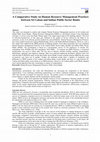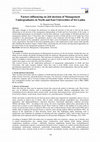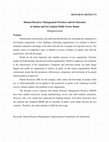Papers by Mangaleswaran Thampoe

Industrial Engineering letters, 2015
This study was designed to explore and compare Human Resource Management practices in Sri Lankan ... more This study was designed to explore and compare Human Resource Management practices in Sri Lankan and
Indian Public Sector Banks. Human Resource Management (HRM) is a developed concept. It has tremendous
relevance to service sector like Bank. Human input is the single largest input to the banking industry. The level
of efficiency/productivity of this input gets reflected in the quality of service offered by the banks to its
customers, as also in its ultimate growth, productivity and profitability. Human Resource Management Practices
have been studied extensively among Manufacturing, Service and Small Medium Enterprises. However, only a
few studies have addressed the HRM practices in banking industry. Even these researchers have not compared
Human Resource Management Practices in Sri Lankan Public Sector banks (SLPBs) and Indian Public Sector
Banks (IPSBs). The investigation is based on a questionnaire survey of 730 employees. It consists 281
respondents from SLPSBs and 449 respondents from IPSBs. . To measure the HRM Practices, a structured
questionnaire was used to collect data. The key area of analysis includes staffing, training, compensation,
performance appraisal, and employee relations. Data were analyzed employing descriptive statistics and t-test
with the help of SPSSThe study reveals that Public Sector Banks in both countries practice HRM but the extent
of practices vary from one to another. Further, the statistical results show a number of similarities and
differences in HRM systems of Sri Lankan and Indian public sectors Banks and there is a gap between Sri
Lankan and Indian public sector banks on its HRM practices. Moreover, Sri Lankan public sector Banks adopted
more rational approach than their counterparts in respect of compensation.
Keywords: Human Resource Management Practices, Public Sector Banks

Journal of Resources Development and Management, 2016
This paper attempts to investigate the preferences on taking the decision of Job and to find out ... more This paper attempts to investigate the preferences on taking the decision of Job and to find out the factors influencing on Job decision of the management undergraduate in North and East Universities of Sri Lanka. A closed ended questionnaire was developed as tool for data collection. A total number of 400 third and final year management students from 3 Universities and 2 Campuses located in North and East of Sri Lanka have been responded to the questionnaire. The quantitative analyses were conducted with the help of SPSS. The result reveals that majority of the respondents’ preferred for future career developments are public sector and private sector organizations. One third of the total respondents plan to seek employment in their chosen field specially after obtaining the bachelor's degree. Further Salary, interesting job, job security and educational opportunity are the major factors for the management graduates in Job decision. Keywords: Job decision, Management, Undergradu...
There is huge investment employed during the last four years by cooperative societies in the Nort... more There is huge investment employed during the last four years by cooperative societies in the Northern Province. Since the overall performance of them are not at the expected level, there is a need to examine them in terms of their financial and operational performance of the cooperatives so as to establish their current status in terms of assets utilization, performance of their business activities and see whether they satisfy the needs of their stakeholders.

Abstract: Quality of Work Life (QWL) is becoming an increasingly popular concept in recent times.... more Abstract: Quality of Work Life (QWL) is becoming an increasingly popular concept in recent times. It basically talks about the methods in which an organization can ensure the holistic well-being of an employee instead of just focusing on work-related aspects. The present study focus is on Quality of Work Life of the Employees: A Case Study of Vavuniya General Hospital, the available literature express that there is very little study on Quality of Work Life of the Employees and no one study Quality of Work Life of the Employees in Government Hospitals in Sri Lanka. Therefore this study attempts to fulfill the above gap. The study purports to explore and gain better understanding of QWL in the Vavuniya General Hospital in Sri Lanka. The researcher collected primary and secondary data. Questionnaire was as a primary tool for data collection. 80 nurses responded to the questionnaires. The quantitative and qualitative analyses were conducted to analyze the collected data. The study resul...

Small and Medium Enterprises (SMEs) play an important role in any economy through generation of e... more Small and Medium Enterprises (SMEs) play an important role in any economy through generation of employments, contributing to the growth of Gross Domestic Production (GDP), embarking on innovations and stimulating of other economic activities. SMEs are facing some difficulties in Knowledge about Management (Human Resources, Finance and Marketing). This research explored that what is the level of HR, Finance & Marketing practices of SMEs in Hambantota District. The main objective of the study is to explore the management practices of SMEs in Hambantota District. The SEMs selected randomly. The researcher collected response from 19 SMEs holders. The main tool of the study was interview guidelines. The data collected from the Owners or Managers of the SMEs via Interview. The Qualitative analyses were conducted. Most of the SMEs have 10-20 employees. Some SMEs are run business with the family support. In the SMEs they prefer to recruit employees with skills and giving on the job training...

This paper investigates the performance of the community based project which was started in 2007 ... more This paper investigates the performance of the community based project which was started in 2007 and implemented by the Social Economical and Environmental Developers (SEED) mainly in the areas of Sekkadipulavu and Rajendrakulam of the Vavuniya district during and after the war in Sri Lanka, especially of the dairy farmers on capacity building and transferring technical expertise to ensure a sustainable intervention. It studies the efficiency level of the implementing partner’s officials, livestock breeders’ cooperative society (Kamathenu), social mobilizers, the animal health workers (animators) and the beneficiaries, the problems encountered and the recommendations for the remedy. It assesses the participatory approach adopted to ensure a high degree of relevance and ownership, income generation activities of the farmers in the dairy sector by organizing them into dairy cooperatives in these locations. It further analyses the collection system efficiency, innovative ideas for econ...
mgmt.cmb.ac.lk
... H1.5: HRM practices dimension, Performance Appraisal will not Page 7. 61 608 ... ACKNOWLEDG... more ... H1.5: HRM practices dimension, Performance Appraisal will not Page 7. 61 608 ... ACKNOWLEDGEMENT We wish to thank Sri Lankan and Indian Public Sector Banks Management and Staff for their support in data collection. ... 'Human Resource Management Practices and its ...

ABSTRACT Vavuniya is an agricultural and cattle breeder district. Milk production is an important... more ABSTRACT Vavuniya is an agricultural and cattle breeder district. Milk production is an important source of livelihood for the rural people. The aim of this study is to map the potentials and challenges of dairy market in Vavuniya district. This study inquires whether milk and milk based products have a good market opportunity and what challenges are faced in marketing milk and milk based products in Vavuniya. Questionnaire survey, interviews and focus group discussion were used to collect primary data from a cross section of dairy consumers, producer groups, institutional representatives and key informants. The research team obtained response from 265 households in four DS divisions. Narrative and statistical analysis methods were used to analyse the primary data. This study is significant in finding out that there exists considerable demand for fresh milk. However, the lack of availability, accessibility, and quality of local fresh milk, and locally processed milk based products have made the consumers resort to seeking more imported powdered milk and milk based products. The study also found that there is considerable willingness to buy or switch to local products when these constraints are addressed. The study concludes that it is a positive trend in developing dairy market in Vavuniya, particularly in a post-conflict setting.

Annamalai International Journal of Business Studies and Research, 2010
ABSTRACT The purpose of this study is to find out the Human Resource Management Practices (HRMP) ... more ABSTRACT The purpose of this study is to find out the Human Resource Management Practices (HRMP) and its outcomes viz. job satisfaction and organizational commitment in Indian public sector banks. HRMP have been studied extensively among manufacturing, service and small medium enterprises. However, only a few studies have addressed the banking industry. Surprisingly, the research studies of this nature have rarely been conducted to assess HRMP and its outcomes in banking environment. Through the survey method by the use of a structured questionnaire designed to test employee’s perceptions, the data were collected. Three public sector banks in India extended cooperation for this study It was targeted to elicit 600 responses from the Indian Public Sector Banks’ employees- 200 from each of the banks. Confirmatory factor analysis, Cronbach alpha, Stepwise Multiple Regression and Structural equation model (Path analysis) were used for various analyses of this study. HRMP are significant predictors of Job Satisfaction and Organizational Commitment; Job Satisfaction dimensions also significantly predict Organizational Commitment; HRMP lead to Job Satisfaction and Organizational Commitment.











Uploads
Papers by Mangaleswaran Thampoe
Indian Public Sector Banks. Human Resource Management (HRM) is a developed concept. It has tremendous
relevance to service sector like Bank. Human input is the single largest input to the banking industry. The level
of efficiency/productivity of this input gets reflected in the quality of service offered by the banks to its
customers, as also in its ultimate growth, productivity and profitability. Human Resource Management Practices
have been studied extensively among Manufacturing, Service and Small Medium Enterprises. However, only a
few studies have addressed the HRM practices in banking industry. Even these researchers have not compared
Human Resource Management Practices in Sri Lankan Public Sector banks (SLPBs) and Indian Public Sector
Banks (IPSBs). The investigation is based on a questionnaire survey of 730 employees. It consists 281
respondents from SLPSBs and 449 respondents from IPSBs. . To measure the HRM Practices, a structured
questionnaire was used to collect data. The key area of analysis includes staffing, training, compensation,
performance appraisal, and employee relations. Data were analyzed employing descriptive statistics and t-test
with the help of SPSSThe study reveals that Public Sector Banks in both countries practice HRM but the extent
of practices vary from one to another. Further, the statistical results show a number of similarities and
differences in HRM systems of Sri Lankan and Indian public sectors Banks and there is a gap between Sri
Lankan and Indian public sector banks on its HRM practices. Moreover, Sri Lankan public sector Banks adopted
more rational approach than their counterparts in respect of compensation.
Keywords: Human Resource Management Practices, Public Sector Banks
Indian Public Sector Banks. Human Resource Management (HRM) is a developed concept. It has tremendous
relevance to service sector like Bank. Human input is the single largest input to the banking industry. The level
of efficiency/productivity of this input gets reflected in the quality of service offered by the banks to its
customers, as also in its ultimate growth, productivity and profitability. Human Resource Management Practices
have been studied extensively among Manufacturing, Service and Small Medium Enterprises. However, only a
few studies have addressed the HRM practices in banking industry. Even these researchers have not compared
Human Resource Management Practices in Sri Lankan Public Sector banks (SLPBs) and Indian Public Sector
Banks (IPSBs). The investigation is based on a questionnaire survey of 730 employees. It consists 281
respondents from SLPSBs and 449 respondents from IPSBs. . To measure the HRM Practices, a structured
questionnaire was used to collect data. The key area of analysis includes staffing, training, compensation,
performance appraisal, and employee relations. Data were analyzed employing descriptive statistics and t-test
with the help of SPSSThe study reveals that Public Sector Banks in both countries practice HRM but the extent
of practices vary from one to another. Further, the statistical results show a number of similarities and
differences in HRM systems of Sri Lankan and Indian public sectors Banks and there is a gap between Sri
Lankan and Indian public sector banks on its HRM practices. Moreover, Sri Lankan public sector Banks adopted
more rational approach than their counterparts in respect of compensation.
Keywords: Human Resource Management Practices, Public Sector Banks